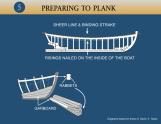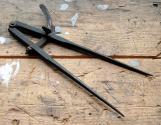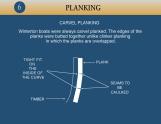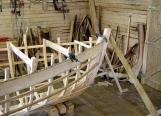14
The breasthook nailed in place at the bow of the boat.15
Cutting a rabbet joint2003
Winterton Boat Building and Community Museum, Newfoundland and Labrador, Canada

16
A rabbet joint (groove to fit the plank ends and edge of the bottom plank) was cut along the stem, the keel and the stern knees including any deadwoods, all the way to the counter. This rabbet, cut using a chisel, would be deep enough and angled correctly to accept the bottom edge of the garboard plank (the bottom plank next to the keel) along the keel. It would also accept the ends of all planks fastened at the stem, and the ends of one or two planks below the counter that stopped at the stern knees or deadwoods.18
Chisels of various sizes were essential in all phases of boat building.19
Preparing to plank2003
Winterton Boat Building and Community Museum, Newfoundland and Labrador, Canada

20
With the risings installed, the rabbet joints cut and the sheer heights marked, planking could begin, usually with the top plank called the binding strake. Shown here are details of the installation of the garboard plank.22
Without exception, the technique of planking used by Winterton boatbuilders was the carvel method, whereby each plank was fitted edge to edge to the adjacent plank and nailed to the stem, stern and timbers. Planks were sawn from 15 to 20 feet fir logs, which were specially selected from trees that were 5 to 10 inches in diameter at the butt end. These trees needed to be relatively knot-free, and have a suent (gradual and smooth) curve over much of the length.In the earliest days a pit saw was used to saw these trees into planks. In later years they would have been taken to the local sawmill which would have a push bench and a large circular saw powered by a diesel engine. In both cases the plank boards would have been cut live-edge (the full width of the log without the bark or edges removed) to a rough thickness of five eighths of an inch to one inch depending on the size of the boat. For a small motorboat of 23 to 26 feet a total of 25 to 30 plank boards would be needed to complete the hull.
23
Selecting planks2003
Winterton Boat Building and Community Museum, Newfoundland and Labrador, Canada

24
Each plank was carefully selected from the pile of previously cut boards. The chosen board had to have the right shape and curve for the section of the boat where it would be attached.25
Dividers, used with the rule staff2003
Winterton Boat Building and Community Museum, Newfoundland and Labrador, Canada

26
Two methods for obtaining the shape of each plank seemed to be used by Winterton boatbuilders. One was the use of a rule staff (a specially selected flexible batten the length of the hull and about 3 or 4 inches wide). The rule staff was bent along the hull from stem to stern roughly in the location of the next plank to be installed. It was important to allow it to follow the hull shape by laying it evenly on each timber without twisting it up or down. It was then clamped or temporarily fastened while a pair of compasses, or dividers, were used to mark on the rule staff the edge of the last plank installed. Marks were made at regular intervals with the compasses/dividers set at a predetermined width thus scribing the plank edge shape on the rule staff.The rule staff was then taken to the bench and placed on a suitable rough plank board where the marks were transferred onto the plank stock thus showing the edge shape of the next plank to be installed. The other edge of this new plank was marked by scribing a smooth gentle curve with a flexible batten usually making the plank wider at the mid-ships and narrower at each end. The plank width at mid-ships compared to the stern and stem could be predetermined by measurement of the relative space to be filled in each hull section.
The other method used was that of tracing one edge of the next plank onto new plank stock that was clamped directly over the last plank installed. From the inside a rough line could then be drawn onto the stock using the last edge installed. This method would give enough information to rough out the next plank. Using either method the final edge shape would be determined by a subsequent series of fitting and cutting until a satisfactory edge-to-edge fit was obtained.


